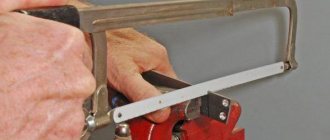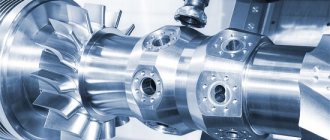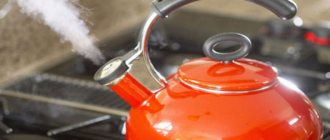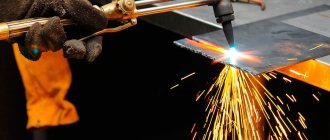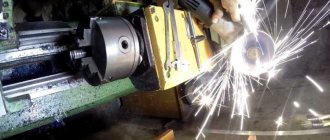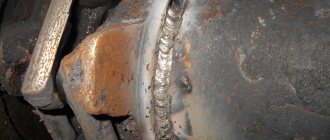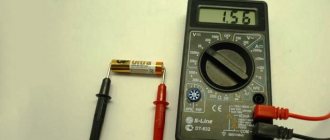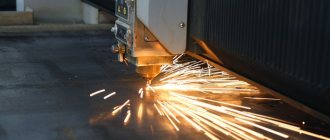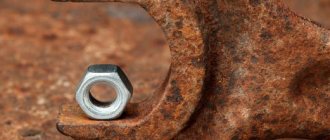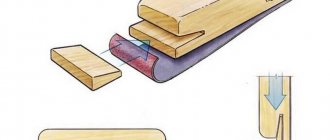Performing an operation
Most cutting is done on a guillotine. This device only vaguely resembles an apparatus for the death penalty, but it performs the main function - it separates one part from another using a heavy blade made of tool steel. Of course, there are more technological methods of sawing - plasma or laser cutting, but they are more expensive.
Various products can be cut:
- sheets;
- rolled metal;
- pipes;
- reinforcement and rods of various sections.
Definition: what is metal cutting?
This is a plumbing operation during which a predetermined division of the workpiece occurs in various proportions. Before this, special markings are applied. The rupture can be carried out both along and across. This is a convenient method because it reduces the number of finishing procedures, and therefore the cost of the finished product. The only caveat is that the edges may turn out a little torn, which means sanding will be required.
This is a preparatory stage, it is not finishing, that is, the last. Tasks that are solved in the process:
- removing excess layer. scale, other defects after casting;
- removal of edges in which high edge stress remains after casting or stamping;
- dividing one product into small elements;
- breakdown of grooves or other functional recesses, grooves.
Applications are in a wide range of areas - from small enterprises to large engineering plants. But the most primitive analogue of the procedure can be performed at home.
Metal cutting methods
Classification can be carried out according to various factors.
According to the task being solved - sawing, cutting, removing a small part or layer. In fact, they all repeat the goals listed above.
By driving force:
- manually;
- using a mechanized machine.
We will discuss this in more detail below.
By forced fixation - in clamps, a vice, as well as with fastening on a special frame and under a press.
In the direction of movement - vertically or horizontally.
The listed methods are selected depending on:
- availability of equipment;
- thickness of the metal product;
- the required level of work - the edges can be bent when done manually, but with a mechanized process the accuracy increases;
- degree of productivity - there is no point in reconfiguring equipment for the sake of one part, but special machines will be required for a serial batch.
Features of combined devices
The equipment includes press shears and corner notching machines.
The first ones chop and cut strip, sheet, shaped and long products. Press shears are indispensable for punching holes in workpieces and cutting open grooves. These combined cutting machines can handle any profile (channel, angle, T/I-beam, circle, square and others).
Combined press shears
Angle notching machines are also called notching dies. They are distinguished by:
- simplicity of design;
- high work productivity;
- increased accuracy of output products.
Used for corner processing of any materials. The compact design includes a measuring scale and chisels for chopping. The stamp for the process is selected depending on the thickness of the sheets.
Some tools used in metal cutting combine manual and mechanized labor. These include:
- pneumatic and electric chipping hammers;
- special machines, where standard chisel cutting techniques are accelerated 5-10 times thanks to the use of special devices.
To give you a clear idea of the characteristics of the devices, let’s look at one example below. In particular, a machine for cutting reinforcement SMZH 172.
What is called manual cutting of metal?
The process can be either horizontal or vertical, depending on the possibility of attaching the sample. First, it is clamped with a vice, if the thickness allows. Otherwise, it is placed on a special table (think about its strength in advance). To reduce the possibility of slipping, you can lay down rubberized pads, or even better, screw screws into the edges on all sides.
Then the tools are prepared. We will talk about them in more detail below, but now we’ll just outline the list of what’s needed – a crosspiece or chisel, hammers.
Next, think about the impact. Of course they vary in strength. But the most severe impact is not always beneficial. First you need to make a sufficient notch in place so that the blade does not move out. If you pound with all your might the first time, you can only achieve a deformed surface and damaged tools. However, the speed and cleanliness of the cut then depends on this.
Impacts can be of three types:
- carpal;
- elbow;
- brachial.
According to where the swing begins. They are presented in order of increasing strength. Also, this parameter increases depending on the length of the hammer handle and its weight.
Features of the manual procedure include:
- low productivity;
- high consumption of labor resources and time;
- low accuracy;
- bad, with obligatory further processing of the log house.
However, this option is advantageous for small-scale production and single products, as well as at home and in the absence of specialized machines.
Techniques and technologies for cutting metal
There are several types of classification based on different criteria. The most common are the following:
- By the nature of the tasks. We listed them in the previous paragraph. There are also atypical tasks for which other methods are used.
- By level of automation: manual and mechanized processing.
- According to the fixation method. This can be a vice or steel substrate, as well as special devices in the design of machine tools.
- In the cutting direction. It can be horizontal or vertical. The choice depends on the possibilities of securing the workpiece.
The best approach depends on various factors, including:
- availability of necessary tools and/or equipment;
- features of the workpiece: type of metal/alloy, thickness, shape, etc.;
- part quality requirements. If a high level of precision is required, machining is usually used;
- volume of production. For serial production of parts, automated CNC machines are usually used. If we are talking about processing single workpieces, it is irrational to reconfigure production. In these cases, manual processing is usually used.
Manual cutting of metal
This type of processing is less productive, so it is more often used to create single parts. Additionally, hand chopping tools, while available in a wide variety, cannot provide the level of precision that CNC machines provide.
Before starting processing, the master must choose the direction of movement of the tool - horizontally or vertically. It all depends on how the workpiece can be secured. The most common fixation option is a vice. They prevent slipping and ensure reliable fastening of the workpiece. Their main disadvantage is limitations on the shape and thickness of parts. Large workpieces are usually processed on a special table, on which a steel plate is mounted for strength. For more reliable fixation, self-tapping screws and rubberized pads are used.
The next stage is the selection of tools. Typically, a hammer, as well as a cross-cutting tool or a chisel are used to perform manual processing. As already mentioned, these tools allow you to work with the most common types of workpieces from most metals.
The required level of quality and accuracy is provided by the skills of the master. We have already mentioned that the chopping process involves breaking through metal in a given area. A crosspiece or chisel provides a targeted application of force, but the master does the main work with a hammer. Of course, one of the key factors in this case is the force of the impact. In this case, more is not always better. Experienced craftsmen first make a notch on the metal to prevent the blade from slipping later. If a craftsman cannot apply force correctly, he risks damaging both the workpiece and the working tool. Experienced machinists, on the other hand, can provide a level of accuracy comparable to that guaranteed by machine tools.
Another important point in the skill of a mechanic concerns working with a hammer. This tool, despite its simplicity, is responsible for the competent application of force and ensures the necessary quality of work. The main movement that a specialist makes is a strike. However, the work of a locksmith is much more complex than solving everyday problems like hammering nails. Even a blow in plumbing has many nuances. There are three types in total:
- carpal;
- brachial;
- ulnar.
In order not to go into details, here is an image from a textbook published in the USSR:
The force of the blow depends on where the swing begins, as well as on the length of the hammer handle. Knowledge of this technique allows the craftsman to apply as much force as is required to create nicks or break through metal.
Manual cutting of metal does not involve a large number of operations. It is necessary to securely fix the workpiece using the available tools, make markings, and then strike with a hammer and chisel. An experienced craftsman can easily control the position and tilt of the tools, as well as the force applied.
The main advantages of manual cutting of metal is the relatively low cost of such work. Even small companies can support one employee and purchase tools. Some chopping tasks can even be done at home.
The disadvantages of this method include:
- Quite low performance. Even an experienced master will not be able to provide speed comparable to a modern machine. As a result, manual processing is used for single parts or in small production.
- Labor intensity. Manual processing cannot be used for workpieces of large size or non-standard shape. In addition, it requires force from the master, which significantly increases the time required for chopping.
- Low accuracy of work. Even the highest quality tools will not produce at a level comparable to CNC machines.
- Low quality log. It must be processed: polished and so on. As a result, the time required to produce each part increases.
Semi-automatic and automatic processing
The operating principle in this case is much simpler: a person makes markings and fixes the workpiece on the machine. All the work associated with the application of force is performed by the machine. Depending on what equipment is installed in the production, the cutting procedure can be performed in semi-automatic or fully automatic mode. In the latter case, the machine independently selects most of the parameters.
The main advantages of this approach are high productivity and level of accuracy. The only disadvantages include the high cost of the necessary equipment: only large companies can buy and maintain machines.
The main type of mechanical cutting of metal is usually considered to be guillotine, that is, produced on a guillotine machine. Modern devices have little in common with the implements used for execution several centuries ago, except for the principle of operation. A guillotine machine requires an oblique blade that moves in one plane without changing the angle of inclination. Such devices cannot be called new: the first samples are, perhaps, the same age as the tools that gave them their name. Modern machines, however, are much more advanced and can operate in both semi-automatic and automatic modes.
Why is technology invented several centuries ago used today in a wide variety of industries? The fact is that guillotine cutting has a number of undeniable advantages, which become even more obvious with the use of modern technologies. These include high quality work and simplicity.
The main elements of a guillotine machine are:
- table for placing workpieces. In some machines it is stationary, while in others it may have moving elements;
- stop-clamp, which reliably secures the workpiece and ensures safety during operation;
- movable upper beam with blade. It is this part of the machine that is responsible for cutting;
- bottom blade. It is not provided for all machine models. It improves the quality and accuracy of cutting and can be used for cutting. The lower blade is usually static;
- presses and clamps. They provide fixation of various types of workpieces in a given position.
It is also important to take into account that today there are machines on the market with different types of drives: manual, hydraulic, pneumatic, and so on.
The operating procedure for this device is quite simple:
- The workpiece is placed on the work table and fixed in a given position.
- After this, the metal is exposed to one or two blades (depending on the type of machine).
When used in good working order, only a very small amount of steel scrap is generated. In addition, subject to proper operation, the edge remaining after cutting does not require further processing, which also reduces the cost and speeds up production.
There are other types of machines for cutting metal, but they are usually used less frequently:
- press;
- scissor presses;
- angle cutting machines.
Device for chopping metal - guillotine
The equipment has a hydraulic drive. The bed itself is very heavy and large. Using the device, you can only make straight cuts (without rounding) horizontally and vertically. If necessary, you can cut out the desired simple geometric shapes - squares, rectangles, rhombuses, etc.
Usually the machine has remote or computerized control. CNC allows you to preset shapes and cutting speed. Mathematical calculations are required to take into account the thickness of the workpiece and other parameters.
Sometimes the units are combined, that is, in addition to guillotine blades, they contain metal shears and a press. This speeds up work and allows for multifunctional operations. Features of the mechanized process:
- High speed.
- Accuracy of sawing.
- Possibility to cut off even the smallest edge.
- Fairly smooth edges.
- Working with metal products of large thickness (rebar, thick walls).
- The mechanic's actions consist only of setting up the machine and monitoring the process. Facilitating the physical labor of workers.
- High performance. Suitable for mass production.
The disadvantages include the high cost and weight of the equipment. Not every production can afford it.
Devices for cutting metal blanks
The history of the use of processing equipment goes back several centuries. Working with metal requires significant physical effort, so craftsmen have always tried to lighten the load and reduce the labor intensity of the process. Evolutionarily, one can imagine the following development of cutting devices:
- Chisel. A simple processing method, but lacking in performance and accuracy. Requires a lot of physical effort and professional skills.
- Manual guillotine. Significantly speeds up the process of cutting metal. The operating principle is based on the use of a lever. The worker independently activates the upper knife, which, like scissors, separates the required element from the sheet. Only metal of small thickness can be processed in this way.
- Automatic guillotine. Hydraulic, pneumatic, electric drive significantly speeds up the operation. The power of the equipment is many times greater than human capabilities, so productivity increases by an order of magnitude compared to using a manual analogue.
- CNC guillotine. A modern way of cutting metal. The operation is carried out according to the program. It is distinguished by high accuracy and productivity. Additional options almost completely eliminate human participation in the work.
If it is necessary to make a hole in the workpiece, special devices are used. Cutting down rather than drilling sheet metal is more effective. The method saves time and makes the operation safer for the worker. The method of making holes by punching holes on a metal sheet less than 2 mm thick is especially appreciated. The set of punches for this operation is sufficient to produce a part with a given diameter tolerance.
The essence of cutting
Metal cutting is a metalworking operation that allows you to detach unnecessary elements (part, layer or defect) from the main workpiece. It helps to remove:
- scale;
- inaccuracies in dimensions if they arose during the production stage of the product;
- burrs.
You can also divide one workpiece into several different parts.
The process occurs by applying physical pressure through a stronger material. Typically, the blades use tool steel with added carbon, which has undergone additional heat treatment and hardening to increase strength. The iron being processed has a less stable chemical lattice, so intermolecular bonds are broken and non-plastic deformation occurs. Sometimes, to speed up the procedure, the sample is subjected to heat treatment.
Tools used for chopping metal
The main cutting blade is located inside the chisel. It looks like this - a short wooden handle, a wide base and a pointed edge itself. sometimes there is no wood at all or it is replaced by durable plastic or rubber. The main thing is that the head can be hit with a hammer, that is, there is a wide part. Let's look at the photo:
The hardness of the blade is of great importance. Typically, tool steel grades U7 or U8 are used, and the strength should not be less than 53 HRC.
Now let's talk about sharpening. The spicier is not always better. After all, if it comes into contact with a worthy obstacle, the tip may simply break. Let's look at the table and determine the angle at which the chisel needs to be sharpened, in accordance with the material being processed:
| Metal | Sharpening angle, degrees |
| Steel | 60 |
| Cast iron and alloys based on it | 70 |
| Tsvetmet | 35-45 |
Now about the head. Ideally, it should be softer than the base, which is why older examples of the tool do not work well. This is due to the fact that upon impact the edges may begin to deform and crumble. Then it is necessary to change the handle in a timely manner. If you use a faulty chisel, you can hit your finger.
an engineer will help – Metal cutting
The cutting process is the process of dividing the workpiece. This process removes excess metal, called stock. Cutting can be done manually using a chisel and mechanical devices. There is manual cutting (often used in subsidiary farming) and mechanical cutting. Mechanical cutting productivity increases up to 6 times.
Let's first look at the cutting process using a chisel and a hammer.
The chisel has a wedge shape with its cutting part. The choice of sharpening angle largely depends on the hardness of the material being processed; the harder the material, the duller the wedge. Recommendations for choosing steel: the cutting wedge angle is 60 degrees; non-ferrous metals, the cutting wedge angle is 35 -40 degrees.
A special chisel is used to obtain grooves using a chisel. When processing by chopping, a hammer weighing up to 500 g is used.
Felling process
During the chopping process, the workpiece is secured in a vice slightly to the left of the right edge of the jaws. The remaining space is used to attach the chisel. The hammer is positioned with the striker to the left and placed on the workbench to the right of the vice, while the chisel is on the left, with the cutting part towards itself. The work area must be protected by a safety net to protect against flying material fragments.
Features of the cabin
There are two ways to cut metal
1. Cutting in a vice according to marking marks. 2. Cutting in a vice, clamping the metal at the level of the jaws of the vice.
Cutting with a vice using marking marks is carried out in such a way that the markings are 1.5-2 mm higher than the jaws of the vice itself. The chisel is positioned at an angle of 30-40° to the workpiece surface. After each blow, you need to return the tool to its original position. Chopping in a vice, clamping the metal at the level of the jaws of the vice, is carried out if the marks are lowered below the level of the jaws, so that after chopping there is an allowance of up to 1.5 mm on the surface of the part.
Depending on the hardness of the material, there are different types of cutting
1. Hand cutting types. 2. Elbow types of cutting. 3. Shoulder types of felling.
The brush type of cutting removes very small irregularities. Elbow types of cutting - remove unnecessary material and chop into pieces a workpiece no more than 10 mm thick. Shoulder type of cutting - removes a thick layer of metal and chops a workpiece of great thickness into pieces.
Features of felling
With the hand type, as one might assume, the hammer moves due to the movement of the hand. In the elbow form, the arm bends at the elbow and the blow becomes stronger. In the shoulder form, it moves away from the shoulder and the blow becomes much stronger.
If the workpiece for cutting cannot be healed in a vice, it is processed on a slab. In this case, the chisel is placed vertically on the marking line and this is the only way to strike. After each such blow, the chisel is moved halfway along its cutting edge.
This method makes it easier to position the chisel in the desired position, which helps ensure a continuous cut. If the workpiece is very thick and simply cannot be cut, then in this case additional marking marks are applied to the opposite side of the cutting.
In this case, the workpiece is cut to approximately half the thickness on one side, then cut on the other side.
If you need to cut a workpiece along a complex profile, then the cutting edge is moved at a distance of up to 2 mm from the marking marks, cutting the metal with light blows along the entire profile. Then the cutting is repeated with stronger blows. Then it is turned over and the cutting is carried out along the designated contour.
Safety features when cutting metal
1. It is allowed to work only with a serviceable tool that does not have cracks or burrs on the striking part. 2. The hammer handle is firmly seated on the baize and has no cracks. 3. You cannot check the quality of cutting by touch. 4. At the end of the cutting, you need to weaken the force of the blow. 5. Metal cutting should be done wearing protective glasses or behind a protective screen.
Mechanical cutting is carried out
using pneumatic chipping hammers using presses using press shears using various modern cutting methods (water cutting, laser cutting, air pressure cutting).
Kreuzmeisel, hammers for chopping metal, photo
The first device is designed for making grooves and holes. It is no larger than an average nail, but with its help you can deform a metal product in the desired proportion. They also occasionally produce caps, but more often it is just a small tool made of a monolithic alloy, which has a flattened main part and a diamond-shaped, pointed working area. Here's what it looks like:
- chisel – used for rough operations;
- crossmeisel - a device for removing small fragments of a surface.
There is no point in talking about hammers in detail, since they are no different from the ones we are used to. Their specific weight ranges from 400 g to 800, depending on the scope of work. The main thing when choosing is to look at the reliability of the installation of the metal part on the handle and the lack of free play.
Manual
Manual cutting is a very simple and common process, well known to almost any car owner or home handyman who has at least once had to pick up a hammer and chisel in order to cut off an extra piece or, for example, a rusted screw.
Actually, a chisel and a hammer are the main tools. As for the hammer, a standard metalworking tool weighing 0.4-0.8 kilograms with a 35-45 centimeter handle is used for work.
A chisel is a carbide metal bar with a cutting edge at one end. The width of the working part, its shape and sharpening angle, as well as the total length of the tool may vary depending on its purpose. The most commonly used chisels are 2 and 2.5 centimeters wide with a flat or slightly rounded cutting edge.
An analogue of a chisel is a crossmeisel. Its main differences lie in the shape of the working part, most often drop-shaped, with a narrow cutting edge (no more than 1 centimeter), and application. While the chisel is used to cut through rolled sheets or separate parts of products, the crossmeisel is mainly used to form various grooves and grooves on the surface of the workpiece.
Additionally, you need to prepare a workplace. This could be a vice, an anvil, or a soft metal backing plate if you need to cut right through the sheet.
The cutting technique varies depending on the workpiece used and the desired result. There are:
- horizontal,
- vertical.
In the first case, the workpiece is clamped in a vice, and the chisel is set at an angle of 30-35 degrees relative to the plane of the table, that is, on the side of the metal product being processed. This, for example, allows you to cut off the excess part of the metal sheet protruding from the vice. The same is true for cross-cutting when it is necessary to cut a groove in the surface of a product. In this case, with each blow, the tip of the tool moves along the intended axis of the cut or groove.
Vertical cutting is used mainly with rolled sheets. With its help, you can cut off an extra piece of the plate or punch a hole of any shape. In this case, the chisel is installed strictly perpendicular to the plane only at the first and last blow, and the main part of the work is carried out with a slight tilt of the tool in the direction opposite to the movement. For greater convenience and accuracy, marking marks can be pre-applied to the sheet, specifying the position of the cutting edge.
Depending on the thickness of the material, work can be carried out on one side or on both sides, followed by separation of the piece by breaking or knocking out.
Working manually, it is almost impossible to ensure high accuracy and productivity, which is why the following methods are used in industry.
Sawing material on an industrial scale
Felling is not often used in industry due to the poor quality of the result. The guillotine method is used exclusively as an intermediate stage of metalworking. But it is not economically profitable to do two tasks instead of one. In order to immediately obtain an ideal cut, as well as work with more complex geometric shapes than a line, factories are equipped with special machines. For example, abrasive. The principle of its operation is that gas under powerful pressure delivers a stream of water mixed with the smallest abrasive. This mixture perfectly penetrates even thick metal, leaving smooth edges. Let's watch the video:
Such equipment, as well as gas, plasma, and laser equipment, is mainly equipped with a CNC control panel. The workpiece is sawn in accordance with a predetermined result and calculations.
Chopping, cutting metal - basic methods and tools
The current level of technology development has long ago turned science fiction into real reality. What could previously be read in books is now used almost everywhere. This applies to a fairly large number of production processes, including such as chopping and metal cutting.
Process Features
Metal cutting is the separation of certain elements from sheet, section or cast metal. At the moment, we can distinguish the following types of cutting:
- mechanical - using a saw, scissors or cutters;
- percussion - using chopping;
- thermal cutting, carried out by heating;
- manual, produced at home, as a rule, does not present any difficulties.
Metal cutting can also be different in shape and nature. Here we can note separation cutting, that is, dividing the material into several parts. There is surface cutting, for example, it can be cutting holes in a part. It is worth noting that manual cutting is carried out with tools such as a grinder or special slotted scissors.
This method does not deserve special attention, since it is considered ineffective, therefore it is used only if it is necessary to carry out work in a small volume. It is better to focus on other popular types of cutting, such as guillotine cutting, plasma, hydraulic, laser, and so on. Hand cutting is in no way comparable to any of these methods. As a rule, each method has its own disadvantages and advantages.
Some methods are limited in the thickness of the metal, there are those that provide a certain level of quality of the resulting surface.
Guillotine
Currently, a device such as a guillotine is used for high-quality cutting of metal. This method is based on the use of various mechanical knives or metal scissors. The essence of a process such as cutting, first of all, is that the process begins with the master placing a sheet of metal on the working surface of the machine and securing it by using a pressure beam.
After this, the knife is installed and the cutting itself is carried out. Using a method such as the guillotine results in a perfectly smooth edge that does not have nicks, burrs or any other unnecessary edges. Another advantage of using a device such as a guillotine when cutting metal is the complete absence of curvature.
This is based on the fact that the cutting process is carried out by the blade strictly along the entire width of the material.
Currently, there are four main types of such a device as a guillotine - manual, pneumatic, hydraulic and electromechanical. They share a similar operating principle, but there are some differences. The machines can be designed to carry out a process such as cutting in width and length.
Almost all options use electronics, which provide high levels of accuracy. It is worth noting that cutting metal with a device such as a guillotine is ideal for processes that involve workpieces.
There are some points that are important to know and observe when implementing this method. There is some limitation on the thickness of the metal, depending on its type, for example, a hydraulic guillotine can process metal, carry out a process such as cutting material whose thickness does not exceed 6 mm.
The accuracy of the strips depends on the qualifications of the operator, and the guillotine does not allow for shaped cutting.
Main types of metal cutting
Band saw cutting is currently very popular, which is popular due to the relatively low cost of the process, ease of maintenance, and acceptable productivity. A band saw is used as a cutting device, which is tensioned on pulleys.
Oxy-fuel cutting is popular due to its high productivity. The essence of the process is based on the combustion of metal. Once the material is heated to the required temperature, cutting is carried out with a stream of oxygen.
Not all types of metal are suitable for this method, in particular aluminum, since when heated the material becomes soft and not intended for cutting. The plasma cutting method is also used, which is carried out by heating the place where it is planned to cut.
At the moment, plasma cutting of metal is considered the most common method, since it does not require the creation of special conditions; the presence of air and electrical energy is sufficient.
One of the advanced methods is laser cutting of metal. By using a laser beam for cutting, it is possible to cut metal whose thickness is approximately 20 mm, but the most optimal option is achieved when working with material whose thickness is 6 mm.
Waterjet cutting, which is a progressive and innovative technology, deserves special attention. This method is able to amaze, since the material is cut using a jet of water, and in this way it is possible to cut steel, the thickness of which is 300 mm! This technology has one big advantage - the water jet is usually as thin as a hair, it creates significantly less material loss when compared to some traditional processes.
Conclusion
To summarize, it can be noted that the above methods are used in practice almost always and everywhere. But this industry is constantly evolving, and newer methods are being developed. Currently, experiments are being conducted with metal cutting using electromagnetic pulses, ultrasound, and so on. There is a possibility that over time a method will be developed that will have high performance and an affordable cost of the process itself.
Source: https://GoodSvarka.ru/rezka-metallov/rubka/
Possible defects
There are moments that cannot be corrected. They accompany virtually every metalworking process in this way. These include:
- edge curvature;
- absence of parallel lines;
- presence of burrs and roughness;
- uneven groove depth.
To minimize the possibility of defective execution, you need to know the reasons:
- poor workpiece fastening;
- crooked marking;
- incorrect impact force;
- poorly sharpened tool.
In the article we talked about all the techniques for cutting metal. Do everything according to the rules prescribed by technology and enjoy excellent results.
To clarify the information you are interested in, contact the managers by phone; (473) 239-65-79;. They will answer all your questions.
Tools and equipment for metal cutting
The most widely used equipment and devices for cutting metal are:
- Guillotine shears
- Chisels (crosscuts)
- Die cutting
- Sweeps
Additionally, there is a tool for making keyways, all kinds of grooves and spline surfaces. But such work already refers to slotting and milling metal-cutting operations . To implement such metalworking, various cutters, cutters and broaches are used.
When creating keyways and spline connections of high precision, pulsed electric burners are often used. In this case, the groove is formed by an electrode, which burns off excess metal.
Now let’s learn more about tools for cutting metal.
